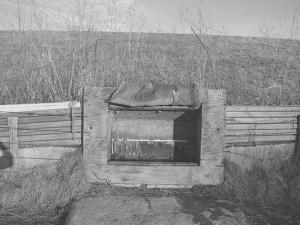2008 - Volume #32, Issue #1, Page #32
[ Sample Stories From This Issue | List of All Stories In This Issue | Print this story
| Read this issue]
No-Freeze Stock Waterer
 |
Robert Przygoda loves his automatic watering tank because it uses no electricity, yet the unit has never frozen shut in winter, and the shaded water doesn't get hot in summer, so there's no algae growth.
"The concrete tank has a roof over it so it's like a cave. The opening across the front is the only part that's not insulated by dirt," he says. "The front opening has a curtain made from strips of old, used carpet and the cows push the strips out of the way with their noses to get a drink."
Przygoda says there have been a few times when there's been a 1/8-in. skin of ice in the tank after the temperature has been around 0 degrees F with a harsh wind for several days. But his cows easily break through that themselves.
The tank holds about 250 gal., and the 16-in. high opening is about 4 ft. wide, allowing three cows to drink at a time. The rug curtain is cut in 2-ft. wide strips, which are tacked onto a board that's nailed to a post on either side of the tank.
In the summer, he's proud to report he's never had to clean the tank out because algae doesn't grow in the shady water.
When building the system, Przygoda dug 18 in. into the ground and made forms to pour concrete. He used old lumber to make the inside form, and relied on the earth wall for the outside form. He poured the floor and walls at the same time, and then the roof. The front end of the roof sits five feet above ground level and it tapers toward the back to about three feet.
Przygoda covered the back end of the tank roof with four feet of dirt, and tapered that forward to none at the very front.
"My water source is a lake so I have a gravity-fed 2-in. dia. pipe that feeds underneath the tank," he says. "Five feet underground, I located a valve on the pipe, just before the water enters the tank. Then, packed in sand just above the valve, I placed a 5-ft. section of 6-in. dia. pipe that gives me above-ground access. In case of an emergency, I can shut that valve off by using a 3/4-in. dia. pipe (5-ft. long) that I can stick down there. I welded a couple of 1/4-in. bolts onto the end of that pipe, which allows me to turn the valve. I've never used any of that, though - I just leave the water on all the time."
Przygoda says the system cost him almost nothing to build 15 years ago. The work took him about 15 hours, once he had come up with a plan.
"If we could make these tanks and deliver them like a septic tank, it would be a good deal," Przygoda comments. "I have just recently passed the farm onto my son, so I guess that will be his decision."
Contact: FARM SHOW Followup, Robert Przygoda, 5983 White Walnut Rd., Pinckneyville, Ill. 62274 (ph 618 336-5561).

Click here to download page story appeared in.

Click here to read entire issue
To read the rest of this story, download this issue below or click here to register with your account number.




